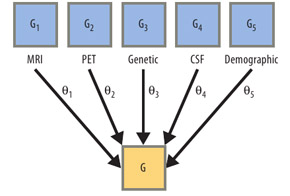Machine Learning Approaches for the Neuroimaging Study of Alzheimer’s Disease
By Jieping Ye, Teresa Wu, Jing Li, and Kewei Chen
NOTE: This is an abstract of the entire article, which appeared in the April 2011 issue of the IEEE Computer magazine.
Click here to read the entire article.
Alzheimer’s disease (AD) is the most common type of dementia, accounting for 60-80 percent of age-related dementia cases. AD progressively destroys neurons and their connections in the brain, leading to loss of cognitive function and, ultimately, death. The disease currently affects about 5.3 million people in the US, and the number of victims will significantly increase in the near future without the development of therapeutics. AD was the seventh-leading cause of death across all ages in the US in 2006; it was the fifth-leading cause of death for those 65 and older (www.alz.org). The direct cost to care for AD patients by family members or healthcare professionals is more than $100 billion per year; this figure is expected to rise dramatically as the population ages during the next several decades.
To avert a healthcare crisis, AD researchers have recently intensified their efforts to delay, cure, or prevent the onset and progression of the disease. These efforts have generated a large amount of data, including brain neuroimages, that provides unprecedented opportunities to investigate AD-related questions with higher confidence and precision. Especially promising is the use of machine learning approaches to analyze neuroimages to improve AD detection and diagnosis. Emerging techniques include the fusion of AD data from multiple sources, AD biomarker identification from multiple sources, and the analysis of functional brain connectivity.
The article presents results achieved using structural magnetic resonance imaging (MRI), which visualizes brain anatomy with a high degree of contrast between brain tissue types and positron emission tomography (PET), which utilizes different radioactive tracers to provide information on various physiological, biochemical, and metabolic processes.
The study used a multisource data fusion technique known as multiple kernel learning (MKL), a technique that synthesizes information from multiple heterogeneous data sources into a rigorous optimization problem. The data source they worked with was from the National Institutes of Health’s Alzheimer’s Disease Neuroimaging Initiative (ADNI), which has become a landmark study in the development of neuroimaging and other biosignatures for the disease. They found that MKL provided significant improvements, both in sensitivity and selectivity, in separating AD patients from normal controls (NC).
Illustration of using multiple kernel learning to fuse data from five sources: structural magnetic resonance imaging (MRI), positron emission tomography (PET), genetic, cerebrospinal fluid (CSF), and demographic. The composite kernel matrix G is a linear combination of the five kernel matrices constructed from these five data sources.
Another urgent task in current AD research is biomarker identification, which can be considered a general feature selection problem. Feature selection algorithms attempt to remove as many irrelevant and redundant features as possible and to find a feature subset such that, with dimensionally reduced data, a learning algorithm can achieve better performance. Here, MKL not only adequately distinguishes AD and NC subjects but also identifies brain regions that play more significant roles than others in AD.
In yet a third area, they employed another machine-learning technique based on sparse inverse covariance estimation (SICE) to identify functional brain connectivity networks from FDG-PET data. SICE makes it possible to identify both the connectivity network structure and connectivity strength for a large number of brain regions with small sample sizes.
Machine learning tools aid many AD-related investigations by enabling multisource data fusion and biomarker identification as well as analysis of functional brain connectivity. Despite these advances, many challenges remain, including more effectively predicting disease progression and using multisource data for efficient clinical treatment evaluation.
AUTHORS
Jieping Ye is an associate professor of computer science, as well as a core faculty member of the Center for Evolutionary Medicine and Informatics, at Arizona State University (ASU). Contact him at jieping.ye@asu.edu.
Teresa Wu is an associate professor of industrial engineering at ASU. Contact her at teresa.wu@asu.edu.
Jing Li is an assistant professor of industrial engineering at ASU. Contact her at jing.li.8@asu.edu.
Kewei Chen is a senior scientist at Banner Alzheimer’s Institute as well as director of the Computational Image Analysis lab at Banner Good Samaritan Medical Center’s PET Center; he is also an adjunct professor at Med-X Research Institute, Shanghai Jiao Tong University, China. Contact him at kewei.chen@bannerhealth.com.







